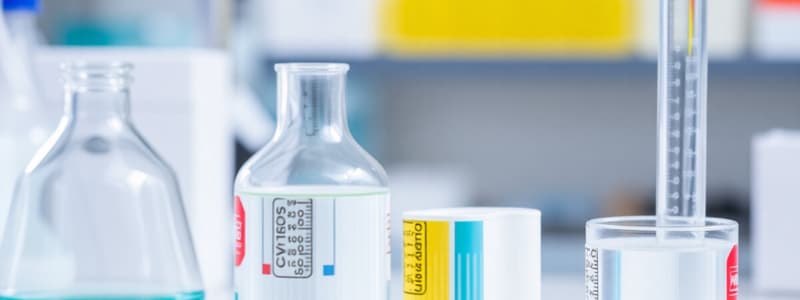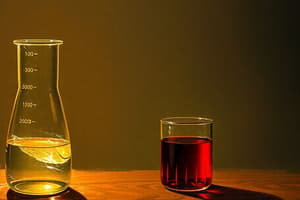Podcast
Questions and Answers
A titration is a laboratory procedure where a measured volume of one solution is added to a known volume of another solution until the reaction is ______.
A titration is a laboratory procedure where a measured volume of one solution is added to a known volume of another solution until the reaction is ______.
complete
The ______ flask is designed to contain a definite volume of solution.
The ______ flask is designed to contain a definite volume of solution.
volumetric
The last few cm3 of water must be added carefully so that the bottom of the meniscus rests on the ______ mark.
The last few cm3 of water must be added carefully so that the bottom of the meniscus rests on the ______ mark.
calibration
A ______ is used to deliver an exact volume of solution.
A ______ is used to deliver an exact volume of solution.
Before use, graduated cylinders should always be rinsed with ______ water.
Before use, graduated cylinders should always be rinsed with ______ water.
The liquid is allowed to run into a beaker until the bottom of the ______ is level with the graduation mark.
The liquid is allowed to run into a beaker until the bottom of the ______ is level with the graduation mark.
A solution is a completely perfect mixture of a ______ and a solvent.
A solution is a completely perfect mixture of a ______ and a solvent.
The tip of the pipette is touched against the side of a glass ______ to remove the drop adhering to the tip.
The tip of the pipette is touched against the side of a glass ______ to remove the drop adhering to the tip.
The concentration of a solution is the amount of ______ that is dissolved in a given volume of solution.
The concentration of a solution is the amount of ______ that is dissolved in a given volume of solution.
It is allowed to discharge slowly into a ______ flask, keeping the tip of the pipette in contact with the side.
It is allowed to discharge slowly into a ______ flask, keeping the tip of the pipette in contact with the side.
10% NaCl w/w means that there are 10 g of sodium chloride per 100 g of ______.
10% NaCl w/w means that there are 10 g of sodium chloride per 100 g of ______.
Before use, the pipette should be rinsed with ______ water to remove contaminants.
Before use, the pipette should be rinsed with ______ water to remove contaminants.
The conical flask should not be washed out with the ______ it is to contain.
The conical flask should not be washed out with the ______ it is to contain.
1 ppm is equivalent to 1 mg of solute per million ______.
1 ppm is equivalent to 1 mg of solute per million ______.
To standardise hydrochloric acid solution, approximately 50 cm3 of the ______ acid solution is poured into a clean dry beaker.
To standardise hydrochloric acid solution, approximately 50 cm3 of the ______ acid solution is poured into a clean dry beaker.
The molarity of a solution is the number of moles of solute per litre of ______.
The molarity of a solution is the number of moles of solute per litre of ______.
When filling the burette, ensure that there are no air ______ in the nozzle.
When filling the burette, ensure that there are no air ______ in the nozzle.
0.85% w/v means that there are 0.85 g NaCl per 100 cm3 of the ______.
0.85% w/v means that there are 0.85 g NaCl per 100 cm3 of the ______.
A 1 M (one molar) solution contains one mole of the solute dissolved in one litre of ______.
A 1 M (one molar) solution contains one mole of the solute dissolved in one litre of ______.
Add 2-3 drops of ______ orange indicator to the sodium carbonate solution in the conical flask.
Add 2-3 drops of ______ orange indicator to the sodium carbonate solution in the conical flask.
To make a 0.85% w/v solution of NaCl, you would need to dissolve ______ g of NaCl in 250 cm3 of solution.
To make a 0.85% w/v solution of NaCl, you would need to dissolve ______ g of NaCl in 250 cm3 of solution.
White crystals are formed in the ______ dish.
White crystals are formed in the ______ dish.
To determine the concentration of ______ in vinegar.
To determine the concentration of ______ in vinegar.
Add 3 drops of ______ indicator to the conical flask.
Add 3 drops of ______ indicator to the conical flask.
At the end point, the phenolphthalein changes from pink to ______.
At the end point, the phenolphthalein changes from pink to ______.
Weigh accurately approximately ______ g of hydrated sodium carbonate into a beaker.
Weigh accurately approximately ______ g of hydrated sodium carbonate into a beaker.
Titrate the sodium carbonate solution against ______ M hydrochloric acid.
Titrate the sodium carbonate solution against ______ M hydrochloric acid.
Methyl orange changes from yellow to ______ at the end point.
Methyl orange changes from yellow to ______ at the end point.
A batch of washing soda crystals had lost some of its water by a process called ______.
A batch of washing soda crystals had lost some of its water by a process called ______.
A chemist was required to determine the percentage water of ______ in the crystals.
A chemist was required to determine the percentage water of ______ in the crystals.
The mean volume of the hydrochloric acid solution required to reach the ______ was 21.6 cm3.
The mean volume of the hydrochloric acid solution required to reach the ______ was 21.6 cm3.
A number of 25.0 cm3 portions of this solution were titrated with a previously ______ hydrochloric acid solution.
A number of 25.0 cm3 portions of this solution were titrated with a previously ______ hydrochloric acid solution.
The balance equation for the titration reaction is: 2HCl + Na2CO3 → 2NaCl + H2O + ______.
The balance equation for the titration reaction is: 2HCl + Na2CO3 → 2NaCl + H2O + ______.
To calculate the concentration of sodium carbonate, the volume and molarity of the ______ solution are used.
To calculate the concentration of sodium carbonate, the volume and molarity of the ______ solution are used.
The chemist should have added the sample to a ______ of deionised water to dissolve it properly.
The chemist should have added the sample to a ______ of deionised water to dissolve it properly.
Add the hydrochloric acid drop by ______ to accurately detect the end point of the titration.
Add the hydrochloric acid drop by ______ to accurately detect the end point of the titration.
The formula for hydrated sodium carbonate is Na2CO3.x H2O, where x represents the number of ______ molecules.
The formula for hydrated sodium carbonate is Na2CO3.x H2O, where x represents the number of ______ molecules.
The balanced equation for the titration reaction indicates that 2 moles of hydrochloric acid react with 1 mole of ______.
The balanced equation for the titration reaction indicates that 2 moles of hydrochloric acid react with 1 mole of ______.
To prepare a 0.05 M primary standard solution, the student must accurately measure a known mass of pure anhydrous ______.
To prepare a 0.05 M primary standard solution, the student must accurately measure a known mass of pure anhydrous ______.
The exact mass of anhydrous sodium carbonate required to prepare the solution was calculated to be ______ grams.
The exact mass of anhydrous sodium carbonate required to prepare the solution was calculated to be ______ grams.
The indicator used for this titration is ______, which changes from orange to red at the end point.
The indicator used for this titration is ______, which changes from orange to red at the end point.
The mean titre during the titration was measured to be ______ cm3.
The mean titre during the titration was measured to be ______ cm3.
The student used a pipette filler to avoid the solution getting into their ______ for hygiene reasons.
The student used a pipette filler to avoid the solution getting into their ______ for hygiene reasons.
The concentration of hydrochloric acid solution can be calculated by using the formula ______.
The concentration of hydrochloric acid solution can be calculated by using the formula ______.
Flashcards
Titration
Titration
A lab procedure where a specific amount of one solution is added to another until the reaction is complete.
Graduated Cylinder
Graduated Cylinder
Used to measure approximate volumes of liquids, not precise measurements.
Volumetric Flask
Volumetric Flask
Used to create a precise volume of solution.
Pipette
Pipette
Signup and view all the flashcards
Meniscus
Meniscus
Signup and view all the flashcards
Solution Concentration (Definition)
Solution Concentration (Definition)
Signup and view all the flashcards
Percentage Concentration (w/w)
Percentage Concentration (w/w)
Signup and view all the flashcards
Percentage Concentration (w/v)
Percentage Concentration (w/v)
Signup and view all the flashcards
Percentage Concentration (v/v)
Percentage Concentration (v/v)
Signup and view all the flashcards
Parts per Million (ppm)
Parts per Million (ppm)
Signup and view all the flashcards
Molarity (Definition)
Molarity (Definition)
Signup and view all the flashcards
1M Solution
1M Solution
Signup and view all the flashcards
Converting Moles/Liter to Grams/Liter
Converting Moles/Liter to Grams/Liter
Signup and view all the flashcards
Pipette Filler Use
Pipette Filler Use
Signup and view all the flashcards
Pipette Tip Placement
Pipette Tip Placement
Signup and view all the flashcards
Conical Flask Purpose
Conical Flask Purpose
Signup and view all the flashcards
Burette Rinse Process
Burette Rinse Process
Signup and view all the flashcards
Burette Use (0 Mark)
Burette Use (0 Mark)
Signup and view all the flashcards
Meniscus Observation
Meniscus Observation
Signup and view all the flashcards
Pipette Rinse Procedure
Pipette Rinse Procedure
Signup and view all the flashcards
Conical Flask Cleaning
Conical Flask Cleaning
Signup and view all the flashcards
Efflorescence
Efflorescence
Signup and view all the flashcards
Hydrated Salt
Hydrated Salt
Signup and view all the flashcards
Water of Crystallization
Water of Crystallization
Signup and view all the flashcards
What is a titration?
What is a titration?
Signup and view all the flashcards
What is the purpose of a burette?
What is the purpose of a burette?
Signup and view all the flashcards
What is the purpose of a pipette?
What is the purpose of a pipette?
Signup and view all the flashcards
What is the purpose of an indicator?
What is the purpose of an indicator?
Signup and view all the flashcards
What is the endpoint of a titration?
What is the endpoint of a titration?
Signup and view all the flashcards
Standard Solution
Standard Solution
Signup and view all the flashcards
Dissolving Washing Soda Crystals
Dissolving Washing Soda Crystals
Signup and view all the flashcards
Precaution During Titration
Precaution During Titration
Signup and view all the flashcards
Suitable Indicator
Suitable Indicator
Signup and view all the flashcards
Calculating Concentration (Moles/L)
Calculating Concentration (Moles/L)
Signup and view all the flashcards
Calculating Concentration (g/L)
Calculating Concentration (g/L)
Signup and view all the flashcards
Percentage Water of Crystallisation
Percentage Water of Crystallisation
Signup and view all the flashcards
Average Number of Water Molecules
Average Number of Water Molecules
Signup and view all the flashcards
Primary Standard Solution
Primary Standard Solution
Signup and view all the flashcards
Anhydrous
Anhydrous
Signup and view all the flashcards
How to prepare a standard solution
How to prepare a standard solution
Signup and view all the flashcards
Why is a pipette filler used?
Why is a pipette filler used?
Signup and view all the flashcards
End Point in Titration
End Point in Titration
Signup and view all the flashcards
Methyl Orange Indicator
Methyl Orange Indicator
Signup and view all the flashcards
Calculation of Concentration
Calculation of Concentration
Signup and view all the flashcards
Study Notes
Volumetric Analysis
- Volumetric analysis is a quantitative method using solution reactions
- Solutions react with each other, used to determine concentrations of solutions accurately.
Expressing Concentrations of Solutions
- Solution: A perfect mixture of solute and solvent (homogeneous)
- Concentration: Amount of solute dissolved in a given volume of solution.
- Different ways to express concentration:
Percentage of Solute
- Weight per weight (w/w): Grams of solute per 100 grams of solution (g/100g)
- Example: 10% NaCl w/w means 10g NaCl in 100g solution
- Weight per volume (w/v): Grams of solute per 100 cm³ of solution (g/100cm³)
- Example: 10% w/v NaCl means 10g NaCl in 100 cm³ solution
- Volume per volume (v/v): Volume of solute per 100 cm³ of solution (cm³/100cm³)
- Example: 10% v/v ethanol means 10 cm³ ethanol in 100 cm³ solution
Moles of Solute per Litre (Molarity)
- Molarity: Moles of solute per litre of solution (M)
- 1M solution contains 1 mole of solute in 1 litre of solution.
- Convert between moles/litre and grams/litre using molar mass.
Parts per Million (ppm)
- Used for very dilute solutions
- 1 ppm = 1 mg/L
Dilution of Solutions
- Number of moles of solute remains constant during dilution.
- M1V1 = M2V2 (where M1 and V1 are initial molarity and volume, and M2 and V2 are final molarity and volume).
Titrations
- Procedure to measure the exact volume of one solution that reacts completely with a known volume of a second solution.
Standard Solutions
- Solutions with known concentrations.
- Primary standard solutions are pure, stable, easily soluble, and have a high molar mass, and undergo complete and rapid reactions.
Reaction Between a Solution and a Solid
- Calculate the mass of Mg that reacts with a given volume and concentration of sulfuric acid (H2SO4).
Studying That Suits You
Use AI to generate personalized quizzes and flashcards to suit your learning preferences.
Related Documents
Description
Test your knowledge on volumetric analysis and the various ways to express concentrations of solutions. This quiz covers percentage calculations and molarity concepts, essential for understanding solution chemistry. Enhance your skills in quantitative chemical analysis today!




